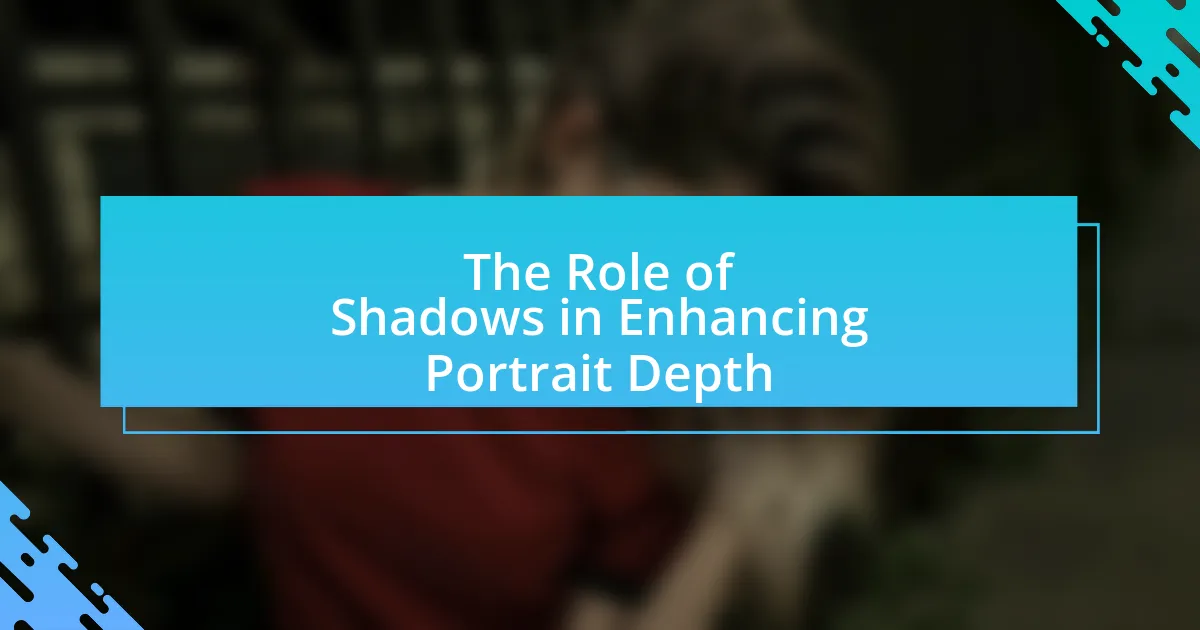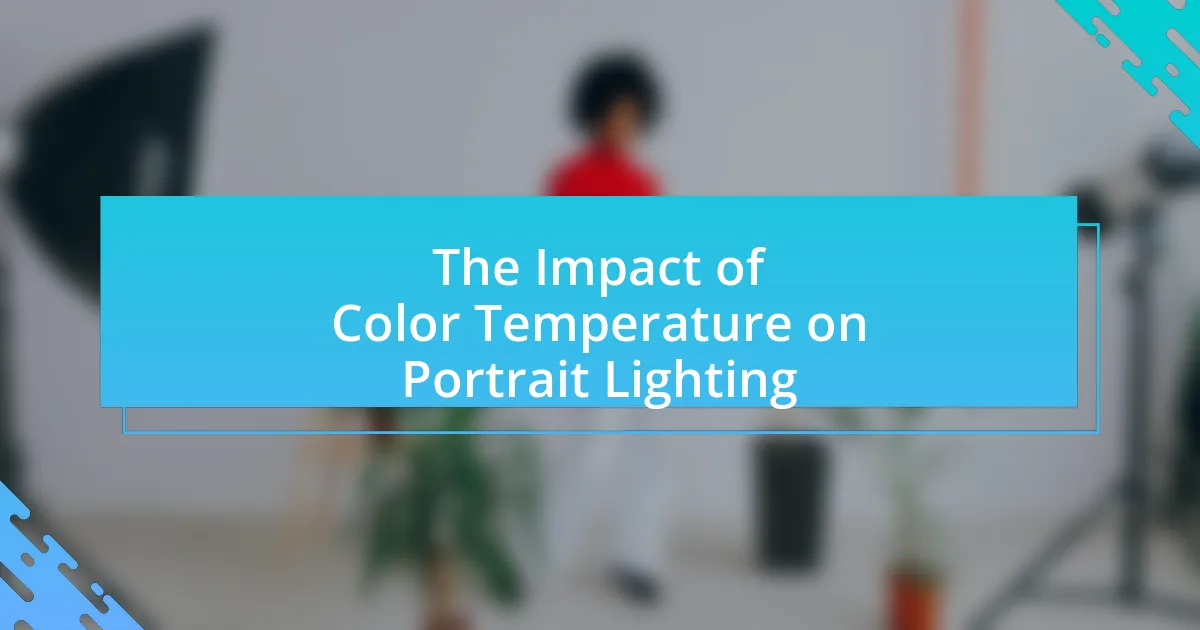Ring lights are circular lighting devices essential for achieving professional-looking portraits in photography. They provide even illumination, reduce shadows, and enhance facial features, making them particularly effective for beauty shots. The article explores the unique characteristics of ring lights, their advantages over traditional lighting sources, and various types available for photographers. It also covers best practices for setup, positioning, and camera settings to optimize lighting quality, as well as creative techniques and common mistakes to avoid when using ring lights. Additionally, it discusses accessories that can enhance the use of ring lights in portrait photography.
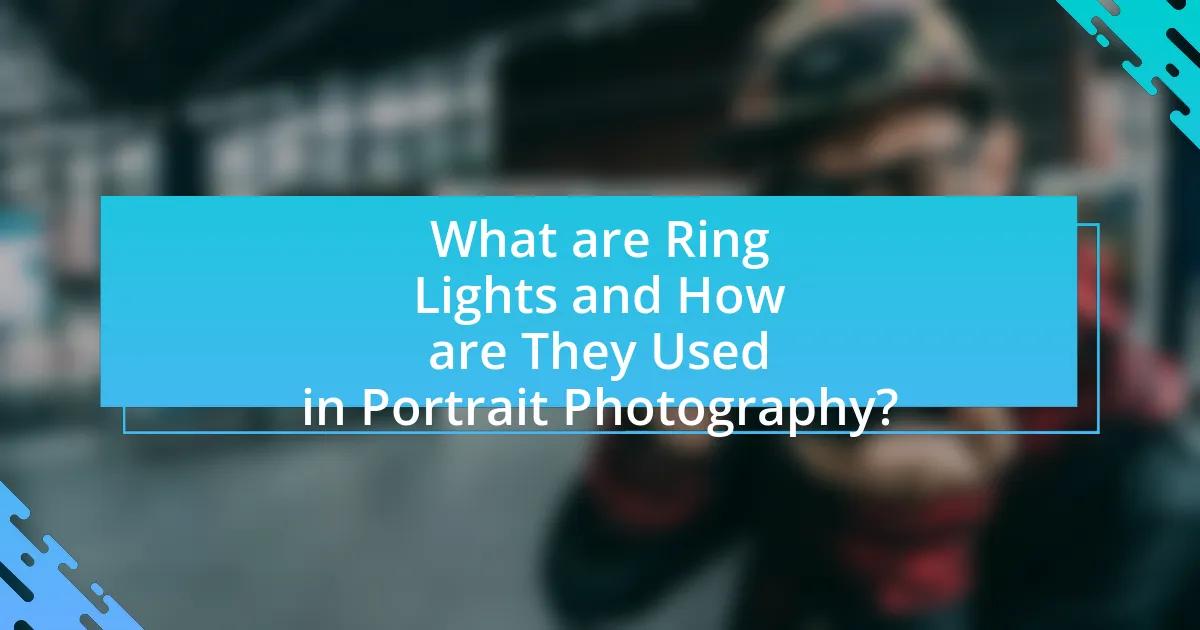
What are Ring Lights and How are They Used in Portrait Photography?
Ring lights are circular lighting devices that provide even illumination and reduce shadows in portrait photography. They are commonly used to create a flattering light effect on the subject’s face, enhancing features and providing a catchlight in the eyes. The design of ring lights allows photographers to position the camera in the center of the light, ensuring that the light source is directly in front of the subject, which minimizes harsh shadows and creates a soft, diffused glow. This technique is particularly effective for beauty shots, as it highlights skin texture and details without overwhelming the subject with light.
How do Ring Lights differ from other lighting sources?
Ring lights differ from other lighting sources primarily in their design and the quality of light they produce. Unlike traditional light sources, which may cast harsh shadows or uneven lighting, ring lights provide a soft, even illumination that minimizes shadows on the subject’s face. This is due to their circular shape, which allows the light to wrap around the subject, creating a flattering effect that is particularly beneficial for portrait photography. Additionally, ring lights often feature adjustable brightness and color temperature settings, enabling users to customize the lighting to suit different environments and preferences, which is not always available with other lighting options.
What are the unique features of Ring Lights?
Ring lights are characterized by their circular design, which provides even and diffused lighting, eliminating harsh shadows on the subject’s face. This unique feature enhances the quality of portraits by creating a flattering, soft glow that highlights facial features. Additionally, ring lights often come with adjustable brightness and color temperature settings, allowing users to customize the lighting to suit different environments and skin tones. The design also enables the camera to be positioned in the center of the ring, ensuring that the light source is directly in front of the subject, which further enhances the overall aesthetic of the portrait.
Why are Ring Lights preferred for portrait photography?
Ring lights are preferred for portrait photography because they provide even, diffused lighting that minimizes shadows and highlights facial features effectively. This type of lighting creates a flattering effect, enhancing the subject’s appearance by illuminating the eyes and reducing blemishes. Additionally, ring lights produce a characteristic catchlight in the eyes, which adds depth and interest to portraits. Their circular design allows photographers to position the light directly in front of the subject, ensuring consistent illumination from all angles.
What types of Ring Lights are available for photographers?
Photographers have access to several types of ring lights, including LED ring lights, fluorescent ring lights, and battery-operated ring lights. LED ring lights are popular for their energy efficiency and adjustable brightness, making them suitable for various lighting conditions. Fluorescent ring lights provide a softer light quality, ideal for portrait photography, but may require more power. Battery-operated ring lights offer portability, allowing photographers to shoot in locations without access to electrical outlets. Each type serves distinct purposes, catering to different shooting environments and preferences.
What are the differences between LED and fluorescent Ring Lights?
LED ring lights and fluorescent ring lights differ primarily in their light source technology and performance characteristics. LED ring lights are energy-efficient, have a longer lifespan, and provide instant brightness without warm-up time, while fluorescent ring lights consume more energy, have a shorter lifespan, and require time to reach full brightness. Additionally, LED lights offer better color accuracy and are less prone to flickering, making them more suitable for professional photography and videography. In contrast, fluorescent lights can produce a cooler color temperature, which may not be ideal for all portrait settings.
How do different sizes of Ring Lights impact portrait photography?
Different sizes of ring lights significantly impact portrait photography by altering the quality and distribution of light on the subject. Larger ring lights produce softer, more diffused light, which minimizes harsh shadows and creates a flattering effect on skin tones, making them ideal for beauty and fashion photography. In contrast, smaller ring lights generate a more concentrated beam of light, resulting in sharper shadows and highlights, which can enhance texture and detail, suitable for artistic or dramatic portraits. Studies indicate that the size of the light source relative to the subject affects the perceived softness of the light; larger sources yield softer light due to the inverse square law, which states that light intensity decreases with distance. Thus, the choice of ring light size directly influences the aesthetic outcome of portrait photography.
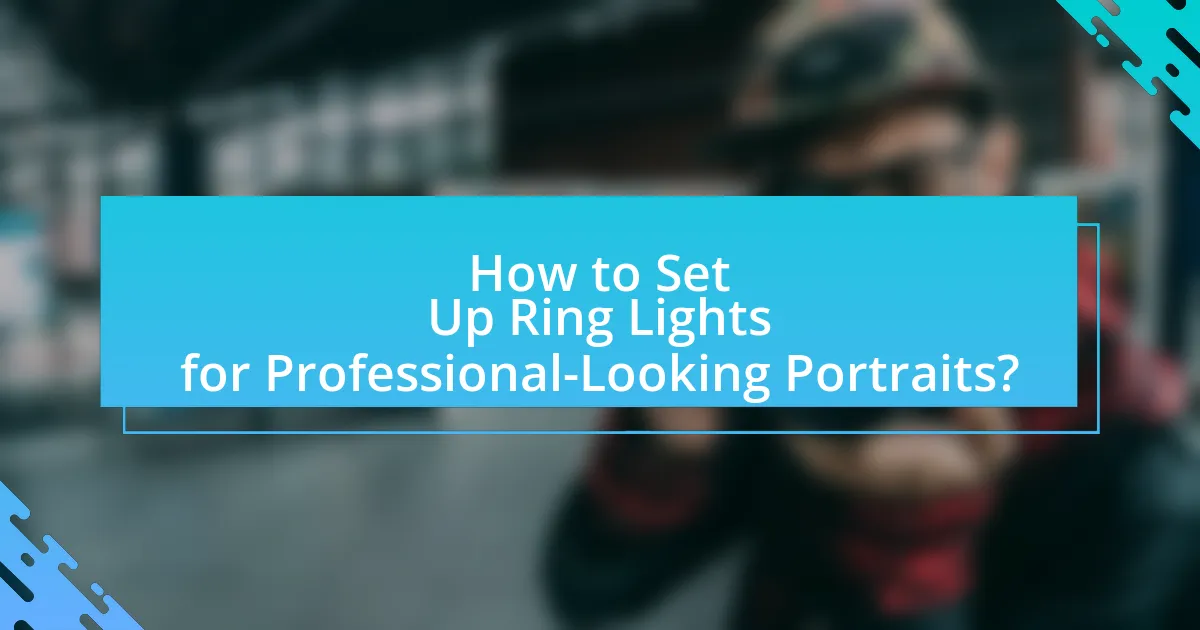
How to Set Up Ring Lights for Professional-Looking Portraits?
To set up ring lights for professional-looking portraits, position the ring light at eye level, approximately 2 to 3 feet away from the subject. This distance helps create even lighting and reduces harsh shadows on the face. Ensure the light is directly in front of the subject to achieve a flattering catchlight in the eyes, which enhances the portrait’s appeal. Adjust the brightness of the ring light to avoid overexposure, typically aiming for a soft glow that highlights the subject’s features without washing them out. Using a diffuser can further soften the light, providing a more natural look. Studies in photography emphasize that proper lighting is crucial for achieving high-quality portraits, as it significantly impacts the overall mood and clarity of the image.
What are the best practices for positioning Ring Lights?
The best practices for positioning ring lights involve placing the light at eye level and directly in front of the subject to achieve even illumination and minimize shadows. This positioning enhances facial features and creates a flattering catchlight in the eyes. Additionally, adjusting the distance between the ring light and the subject can control the intensity of the light; closer placement results in softer light, while further placement yields a harsher effect. Properly angling the ring light can also help reduce glare and ensure that the light wraps around the subject effectively, providing a professional look.
How does the distance from the subject affect lighting quality?
The distance from the subject significantly affects lighting quality by altering the intensity and softness of the light. As the distance increases, the light intensity decreases due to the inverse square law, which states that light intensity diminishes with the square of the distance from the source. For instance, if a ring light is moved from 1 meter to 2 meters away from the subject, the light intensity can drop to one-fourth of its original strength. Additionally, greater distances can lead to harsher shadows and less flattering illumination, as the light becomes less diffused. Therefore, maintaining an optimal distance is crucial for achieving the desired lighting effect in portrait photography.
What angles should be considered when using Ring Lights?
When using ring lights, the primary angles to consider are straight-on, 45-degree, and overhead angles. The straight-on angle provides even illumination and minimizes shadows on the face, making it ideal for beauty shots. The 45-degree angle creates depth and dimension, enhancing facial features while still providing flattering light. The overhead angle can be used for dramatic effects or to highlight specific areas, but it may create shadows under the chin and eyes. Each angle serves a distinct purpose in achieving professional-looking portraits, as supported by photography guidelines that emphasize the importance of light direction in portraiture.
What settings should be adjusted on the camera when using Ring Lights?
When using ring lights, the camera settings that should be adjusted include aperture, shutter speed, and ISO. A wider aperture (lower f-stop number) allows more light in, creating a softer background blur, while a shutter speed of 1/60 seconds or faster helps to prevent motion blur. Additionally, setting the ISO to a lower value, such as 100 or 200, minimizes noise and maintains image quality in well-lit conditions provided by the ring light. These adjustments ensure optimal exposure and clarity in portraits illuminated by ring lights.
How do ISO, aperture, and shutter speed interact with Ring Light usage?
ISO, aperture, and shutter speed interact with Ring Light usage by collectively determining the exposure and quality of the image. ISO controls the camera’s sensitivity to light; a higher ISO allows for better performance in low-light conditions, which can be beneficial when using a Ring Light. Aperture, measured in f-stops, affects the depth of field and the amount of light entering the camera; a wider aperture (lower f-stop number) allows more light, which can enhance the effect of the Ring Light. Shutter speed dictates how long the camera’s sensor is exposed to light; a faster shutter speed can prevent motion blur, especially in well-lit conditions provided by the Ring Light. Balancing these three settings ensures optimal exposure and image quality, making them essential for achieving professional-looking portraits.
What white balance settings work best with Ring Lights?
The best white balance settings for ring lights are typically between 5000K to 6000K, which corresponds to daylight settings. This range effectively neutralizes the color temperature emitted by most ring lights, ensuring accurate skin tones and vibrant colors in portraits. Studies in photography emphasize that using a daylight-balanced setting minimizes color casts and enhances the overall quality of the image, making it ideal for professional-looking portraits.
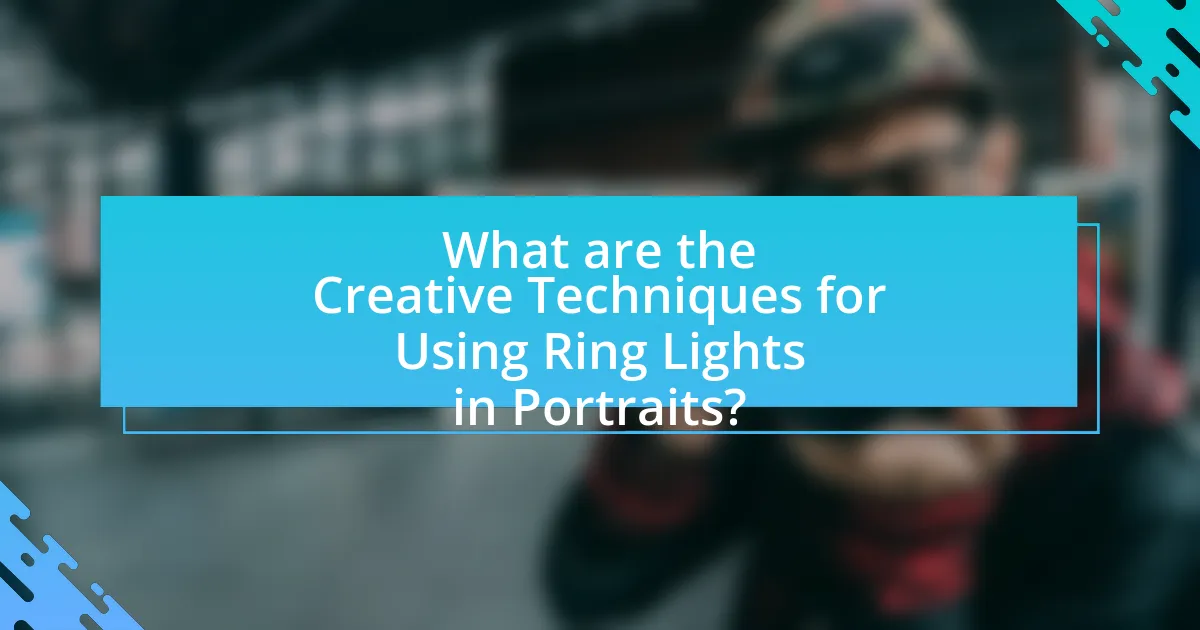
What are the Creative Techniques for Using Ring Lights in Portraits?
Creative techniques for using ring lights in portraits include positioning the light at different angles to create unique shadows and highlights, utilizing colored gels to alter the light’s hue for mood enhancement, and incorporating reflections in the eyes for a captivating catchlight effect. These methods enhance the visual appeal of portraits by adding depth and interest. For instance, placing the ring light slightly above the subject can produce flattering shadows on the face, while using colored gels can evoke specific emotions or themes in the portrait.
How can Ring Lights enhance the mood of a portrait?
Ring lights enhance the mood of a portrait by providing even, flattering illumination that reduces shadows and highlights facial features. This type of lighting creates a soft, diffused glow that can evoke a sense of warmth and intimacy, making subjects appear more approachable and engaging. Additionally, ring lights can produce catchlights in the eyes, which adds depth and liveliness to the portrait, further enhancing emotional expression. Studies in photography have shown that proper lighting significantly impacts the viewer’s perception of mood, with soft lighting often associated with positive emotions and a welcoming atmosphere.
What color gels can be used with Ring Lights for creative effects?
Color gels that can be used with ring lights for creative effects include red, blue, green, yellow, and orange gels. These colors can alter the light output, creating various moods and enhancing the visual appeal of portraits. For instance, red gels can evoke warmth and passion, while blue gels can introduce a cool, calming effect. The use of these gels is common in photography to achieve specific artistic outcomes, as they allow photographers to manipulate color temperature and create dynamic lighting scenarios.
How can shadows be manipulated using Ring Lights?
Shadows can be manipulated using ring lights by adjusting their position and intensity to create desired lighting effects. When a ring light is placed directly in front of the subject, it minimizes shadows on the face, resulting in a flat, even illumination. Conversely, positioning the ring light at an angle can create more defined shadows, enhancing facial features and adding depth to the portrait. Additionally, dimming the ring light can soften shadows, while increasing brightness can intensify them. This versatility allows photographers to control the mood and dimension of their portraits effectively.
What are common mistakes to avoid when using Ring Lights?
Common mistakes to avoid when using ring lights include improper positioning, incorrect brightness settings, and neglecting to diffuse the light. Positioning the ring light too close or too far from the subject can create unflattering shadows or overexposure. Setting the brightness too high can lead to harsh lighting, while too low can result in insufficient illumination. Additionally, failing to use a diffuser can cause the light to appear harsh and unflattering, which detracts from the quality of the portrait. These mistakes can significantly impact the overall aesthetic of the portrait, making it essential to adjust the ring light correctly for optimal results.
How can overexposure be prevented in portraits with Ring Lights?
Overexposure in portraits with ring lights can be prevented by adjusting the light intensity and positioning the light at an appropriate distance from the subject. Reducing the brightness of the ring light helps control the amount of light hitting the subject, while positioning it further away can diffuse the light, minimizing harsh highlights. Additionally, using a diffuser or softbox can soften the light, further reducing the risk of overexposure. These methods are supported by photography principles that emphasize the importance of light control in achieving balanced exposure.
What are the pitfalls of improper positioning of Ring Lights?
Improper positioning of ring lights can lead to unflattering shadows and uneven lighting on the subject’s face. When the ring light is too high or too low, it can create harsh shadows under the chin or above the eyes, detracting from the overall quality of the portrait. Additionally, if the ring light is positioned too far away, the light may not adequately illuminate the subject, resulting in a dim or poorly lit image. Conversely, placing the ring light too close can cause overexposure and a washed-out appearance. These pitfalls highlight the importance of correct positioning to achieve balanced and professional-looking portraits.
What are some practical tips for achieving the best results with Ring Lights?
To achieve the best results with ring lights, position the light at eye level and maintain a distance of about 2 to 3 feet from the subject. This setup minimizes harsh shadows and creates even lighting on the face. Additionally, adjust the brightness to avoid overexposure, as ring lights can produce intense illumination. Using a diffuser can soften the light, enhancing skin tones and reducing glare. Finally, experiment with angles and distances to find the most flattering look, as different subjects may require unique setups for optimal results.
How can one maintain consistent lighting across multiple shots?
To maintain consistent lighting across multiple shots, one should use the same lighting setup, including the same ring light position, intensity, and color temperature. Consistency in lighting is crucial for achieving a uniform look in portraits, as variations can lead to distracting shadows and color discrepancies. Additionally, using a light meter can help ensure that the exposure remains the same across different shots, providing measurable data to adjust settings accordingly. Studies in photography emphasize that maintaining the same distance from the subject and using the same camera settings further enhances lighting consistency, ensuring that the final images have a cohesive appearance.
What accessories can enhance the use of Ring Lights in portrait photography?
Softboxes can enhance the use of ring lights in portrait photography by diffusing the light, resulting in softer shadows and a more flattering appearance on the subject’s skin. Additionally, colored gels can be used to modify the light’s color temperature, allowing for creative effects and mood settings in portraits. Light stands provide stability and flexibility in positioning the ring light, ensuring optimal lighting angles. Finally, a remote trigger allows photographers to take shots without needing to manually adjust the ring light, facilitating smoother shooting sessions. These accessories collectively improve the quality and versatility of lighting in portrait photography.















